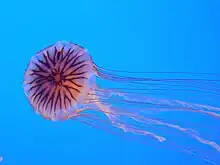Chrysaora pacifica
Chrysaora pacifica, commonly named the Japanese sea nettle, is a jellyfish in the family Pelagiidae.[1] This common species is native to the northwest Pacific Ocean, including Japan and Korea, but it was formerly confused with the larger and more northerly distributed C. melanaster.[2] As a consequence, individuals kept in public aquariums have often been mislabelled as C. melanaster.[3] The medusae of C. pacifica typically has a bell with a diameter of 15–21 cm (5.9–8.3 in). Its sting is strong and can be dangerous to humans.[2]
| Chrysaora pacifica | |
|---|---|
 | |
| Scientific classification | |
| Domain: | Eukaryota |
| Kingdom: | Animalia |
| Phylum: | Cnidaria |
| Class: | Scyphozoa |
| Order: | Semaeostomeae |
| Family: | Pelagiidae |
| Genus: | Chrysaora |
| Species: | C. pacifica |
| Binomial name | |
| Chrysaora pacifica (Goette, 1886) | |
| Synonyms | |
| |
Functions
If the jellyfish sustained injuries, they would go through the process of symmetrization, in which they would restructure their figures by moving around existing parts and not recreating the ones lost to maintain balance.[4]
References
- "WoRMS - World Register of Marine Species - Chrysaora pacifica (Goette, 1886)". www.marinespecies.org. Retrieved 2018-01-21.
- Lee, H.E.; Yoon, W.D.; Chae, J.; Ki, J.-S. (2016). "Re-description of Chrysaora pacifica (Goette, 1886) (Cnidaria, Scyphozoa) from Korean Coastal waters: morphology and molecular comparisons". Ocean and Polar Research. 38 (4): 295–301. doi:10.4217/opr.2016.38.4.295.
- Gaffney, Patrick M.; Collins, Allen G.; Bayha, Keith M. (2017-10-13). "Multigene phylogeny of the scyphozoan jellyfish family Pelagiidae reveals that the common U.S. Atlantic sea nettle comprises two distinct species (Chrysaora quinquecirrha and C. chesapeakei)". PeerJ. 5: e3863. doi:10.7717/peerj.3863. ISSN 2167-8359. PMC 5642265. PMID 29043109.
- Abrams, Michael J.; Basinger, Ty; Yuan, William; Guo, Chin-Lin; Goentoro, Lea (June 15, 2015). Tabin, Clifford J. (ed.). "Self-repairing symmetry in jellyfish through mechanically driven reorganization". Proceedings of the National Academy of Sciences. 112 (26): E3371. Bibcode:2015PNAS..112E3365A. doi:10.1073/pnas.1502497112. PMC 4491739. PMID 26080418.